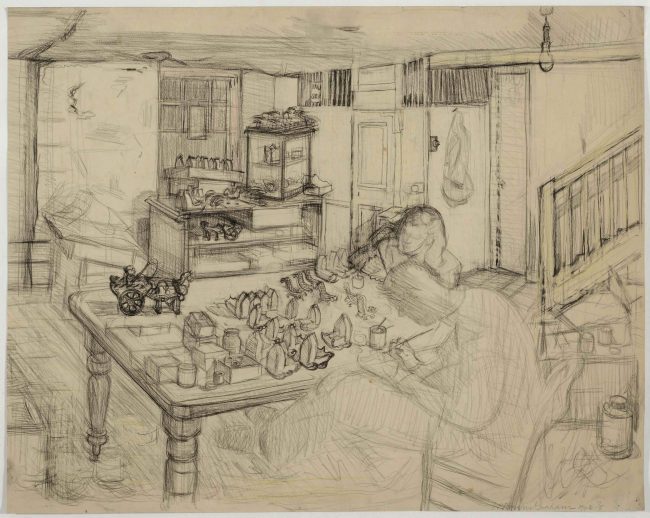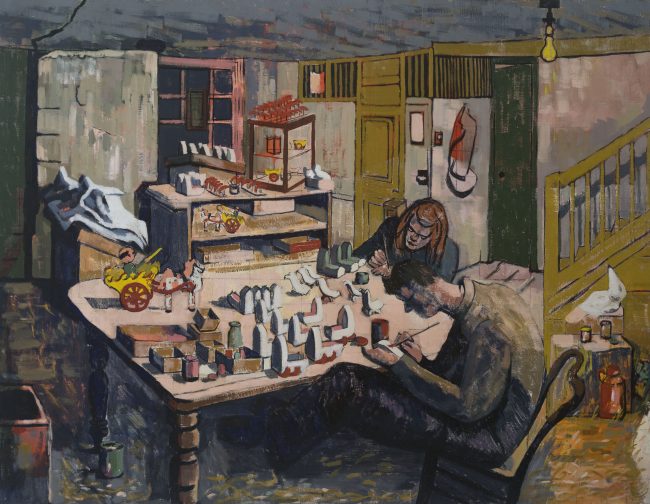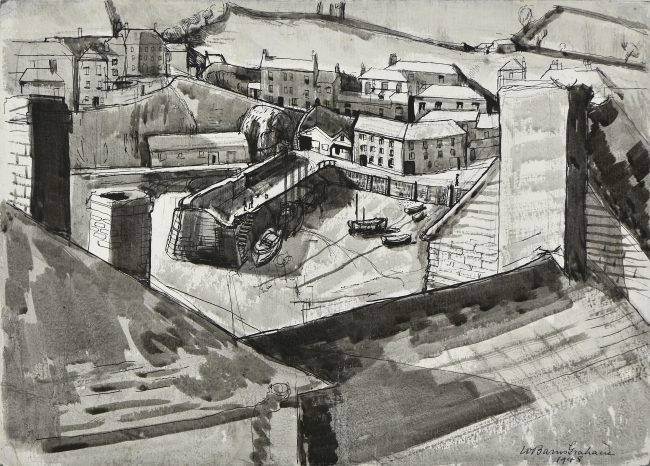A New Acquisition

Toy Workshop The Digey St Ives, 1944-45, Pencil and crayon on paper, BGT10502
On holding an extensive collection of the work of Wilhelmina Barns-Graham the Wilhelmina Barns-Graham Trust rarely feels compelled to add to it. But just occasionally it does, should the work in question either have a close bearing on another within the collection or it fills a gap. It is an exciting moment therefore that the Trust can announce that it has acquired The Toy Workshop, The Digey, St Ives, a pencil and crayon drawing from 1944-5. The drawing had long been thought a stand-alone picture. Held in a private collection it was included in the artist’s 1989 retrospective exhibition and illustrated in the major monograph by Lynne Green – W. Barns-Graham: a studio life – first published in 2001 (Fig 31).
It was with great surprise therefore that in 2007 a painting of this image turned up unexpectedly, revealed among a number of rolled-up canvases that had been transported to Wilhelmina Barns-Graham’s St Andrews home, Balmungo House, after the clearance of her St Ives studio in 2005. Its’ whereabouts considered unknown, the painting had clearly never left the artist’s ownership, the likelihood being that it had been removed from its stretcher for the stretcher to be reused for a new painting. Mixed within a bundle of unframed canvases it became lost at the back of the studio.
For the Trust to now have both the painting and its preparatory drawing is a unique circumstance as there no other two such related works in the collection. Barns-Graham was to say, in reference to her later work, that “I don’t work directly from them [drawings] afterwards; they’re drawings, studies, straightforward….” But at this time, during the 1940s, this was evidently not the case, as The Toy Workshop illustrates. Indeed, the painting follows closely the overall design and details of the drawing – one can see sections of the underlying squaring up that she used to assist with the transfer of the image from paper to canvas – with only very minor modifications. It is fascinating to be able to compare directly these two works and note the small differences between them where, for example, shorthand strokes of the paint brush eliminate a particular pencil detail.
Constructionally, the drawing has a strong diagonal emphasis that takes the eye into the far reaches of the room. The lines of sight are set by the angles of the items of furniture and objects. This is enhanced by the more strongly drawn features that contrast the barely drawn foreground figure. It is a triangular design, with the apex of the triangle being the corner cabinet, and the base aligned between the foreground corner of the table, left, and the back of the tilted chair, right. In the painting her use of red on selected objects further accentuates the way the eye is led around this triangular composition. It is a daring design and one she also used in landscape drawings. In Mevagissey I (1948, BGT1395), for example, a similar triangular schema is created by the rooftops harbour wall and hillside houses surrounding the harbour. This format anticipates the more flattened compositions of the following decade with their tilted, angled shapes.
A label on the reverse of the picture frame informs us that ‘The toy shop, located in a narrow passage off The Digey, struck the artist as a superb theme for a painting: “the little toys were in bright reds , yellows and greens and Van Gogh would have loved them”, though the “smell of paint and varnish under that low ceiling was awful.” The woman in the picture is Susan Lethbridge [who founded the Toy Trumpet, in The Digey where she sold her own and handmade toys], who married the artist Bryan Wynter and the man with her was the artist the late Tom Early’.
Regarding the date of the drawing all the labels on the reverse of the frame state this to be 1944. The date written on the front of the drawing itself shows 1944-5 though there is a suggestion that the ‘-5’ has been added later.
A small group of Wilhelmina Barns-Graham’s interior scenes have been collated on the Trust’s web site here. They were all produced within a particular period between 1937 and 1949 when she visited Switzerland’s Grindelwald Glacier, an experience that changed her art forever.

The Toy Workshop, 1945, Oil on canvas, 87 x 110 cm, BGT3259

Mevagissey I, 1948, Pen, ink and wash on paper, 41 x 49 cm, BGT1395
